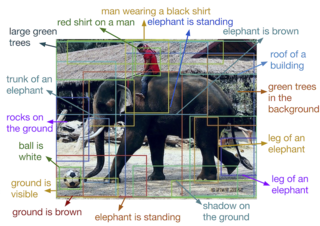A recommender system, or a recommendation system, is a subclass of information filtering system that provides suggestions for items that are most pertinent to a particular user. Recommender systems are particularly useful when an individual needs to choose an item from a potentially overwhelming number of items that a service may offer.

Automatic image annotation is the process by which a computer system automatically assigns metadata in the form of captioning or keywords to a digital image. This application of computer vision techniques is used in image retrieval systems to organize and locate images of interest from a database.

Waikato Environment for Knowledge Analysis (Weka) is a collection of machine learning and data analysis free software licensed under the GNU General Public License. It was developed at the University of Waikato, New Zealand and is the companion software to the book "Data Mining: Practical Machine Learning Tools and Techniques".
Cold start is a potential problem in computer-based information systems which involves a degree of automated data modelling. Specifically, it concerns the issue that the system cannot draw any inferences for users or items about which it has not yet gathered sufficient information.

James Ze Wang is a Chinese-American computer scientist. He is a distinguished professor of the College of Information Sciences and Technology at Pennsylvania State University. He is also an affiliated professor of the Molecular, Cellular, and Integrative Biosciences Program; the Computational Science Graduate Minor; and the Social Data Analytics Graduate Program. He is co-director of the Intelligent Information Systems Laboratory. He was a visiting professor of the Robotics Institute at Carnegie Mellon University from 2007 to 2008. In 2011 and 2012, he served as a program manager in the Office of International Science and Engineering at the National Science Foundation. He is the second son of Chinese mathematician Wang Yuan.
In pattern recognition, the iDistance is an indexing and query processing technique for k-nearest neighbor queries on point data in multi-dimensional metric spaces. The kNN query is one of the hardest problems on multi-dimensional data, especially when the dimensionality of the data is high. The iDistance is designed to process kNN queries in high-dimensional spaces efficiently and it is especially good for skewed data distributions, which usually occur in real-life data sets. The iDistance can be augmented with machine learning models to learn the data distributions for searching and storing the multi-dimensional data.

Reverse image search is a content-based image retrieval (CBIR) query technique that involves providing the CBIR system with a sample image that it will then base its search upon; in terms of information retrieval, the sample image is very useful. In particular, reverse image search is characterized by a lack of search terms. This effectively removes the need for a user to guess at keywords or terms that may or may not return a correct result. Reverse image search also allows users to discover content that is related to a specific sample image or the popularity of an image, and to discover manipulated versions and derivative works.
KNIME, the Konstanz Information Miner, is a free and open-source data analytics, reporting and integration platform. KNIME integrates various components for machine learning and data mining through its modular data pipelining "Building Blocks of Analytics" concept. A graphical user interface and use of JDBC allows assembly of nodes blending different data sources, including preprocessing, for modeling, data analysis and visualization without, or with only minimal, programming.
Learning to rank or machine-learned ranking (MLR) is the application of machine learning, typically supervised, semi-supervised or reinforcement learning, in the construction of ranking models for information retrieval systems. Training data may, for example, consist of lists of items with some partial order specified between items in each list. This order is typically induced by giving a numerical or ordinal score or a binary judgment for each item. The goal of constructing the ranking model is to rank new, unseen lists in a similar way to rankings in the training data.
The term is used for two different things:
- In computer science, in-memory processing (PIM) is a computer architecture in which data operations are available directly on the data memory, rather than having to be transferred to CPU registers first. This may improve the power usage and performance of moving data between the processor and the main memory.
- In software engineering, in-memory processing is a software architecture where a database is kept entirely in random-access memory (RAM) or flash memory so that usual accesses, in particular read or query operations, do not require access to disk storage. This may allow faster data operations such as "joins", and faster reporting and decision-making in business.
An AI accelerator, deep learning processor, or neural processing unit (NPU) is a class of specialized hardware accelerator or computer system designed to accelerate artificial intelligence and machine learning applications, including artificial neural networks and machine vision. Typical applications include algorithms for robotics, Internet of Things, and other data-intensive or sensor-driven tasks. They are often manycore designs and generally focus on low-precision arithmetic, novel dataflow architectures or in-memory computing capability. As of 2024, a typical AI integrated circuit chip contains tens of billions of MOSFET transistors.
The following outline is provided as an overview of and topical guide to machine learning:
Automated machine learning (AutoML) is the process of automating the tasks of applying machine learning to real-world problems.
Matrix factorization is a class of collaborative filtering algorithms used in recommender systems. Matrix factorization algorithms work by decomposing the user-item interaction matrix into the product of two lower dimensionality rectangular matrices. This family of methods became widely known during the Netflix prize challenge due to its effectiveness as reported by Simon Funk in his 2006 blog post, where he shared his findings with the research community. The prediction results can be improved by assigning different regularization weights to the latent factors based on items' popularity and users' activeness.
Spark NLP is an open-source text processing library for advanced natural language processing for the Python, Java and Scala programming languages. The library is built on top of Apache Spark and its Spark ML library.
Automated Artificial Intelligence (AutoAI) is a variation of the automated machine learning or AutoML technology, which extends the automation of model building towards automation of the full life cycle of a machine learning model. It applies intelligent automation to the task of building predictive machine learning models by preparing data for training and identifying the best type of model for the given data. then choosing the features or columns of data that best support the problem the model is solving. Finally, automation evaluates a variety of tuning options to reach the best result as it generates, then ranks, model-candidate pipelines. The best performing pipelines can be put into production to process new data, and deliver predictions based on the model training. Automated artificial intelligence can also be applied to making sure the model doesn't have inherent bias and automating the tasks for continuous improvement of the model. Managing an AutoAI model requires frequent monitoring and updating, managed by a process known as model operations or ModelOps.
Wei Wang is a Chinese-born American computer scientist. She is the Leonard Kleinrock Chair Professor in Computer Science and Computational Medicine at University of California, Los Angeles and the director of the Scalable Analytics Institute (ScAi). Her research specializes in big data analytics and modeling, database systems, natural language processing, bioinformatics and computational biology, and computational medicine.
In network theory, collective classification is the simultaneous prediction of the labels for multiple objects, where each label is predicted using information about the object's observed features, the observed features and labels of its neighbors, and the unobserved labels of its neighbors. Collective classification problems are defined in terms of networks of random variables, where the network structure determines the relationship between the random variables. Inference is performed on multiple random variables simultaneously, typically by propagating information between nodes in the network to perform approximate inference. Approaches that use collective classification can make use of relational information when performing inference. Examples of collective classification include predicting attributes of individuals in a social network, classifying webpages in the World Wide Web, and inferring the research area of a paper in a scientific publication dataset.

Edward Y. Chang is a computer scientist, academic, and author. He is an adjunct professor of Computer Science at Stanford University, and Visiting Chair Professor of Bioinformatics and Medical Engineering at Asia University, since 2019.





